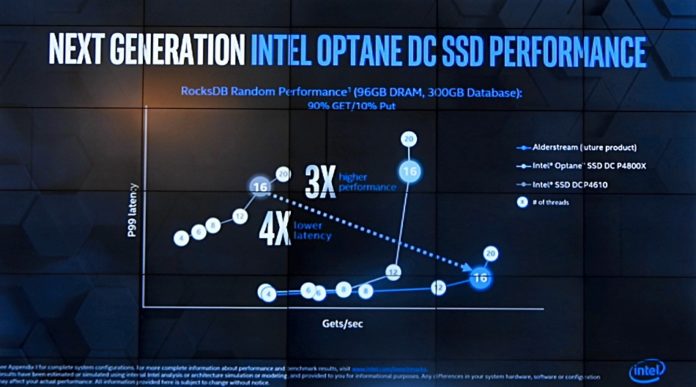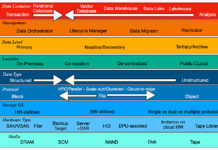Intel showed off some performance figures for upcoming Alder Stream second generation Optane SSDs today at its Seoul Memory and Storage Day The info is a little sparse and presented in slide format. But it shows that Alder Stream should deliver at least 50 per cent better performance than the first generation P4800X Optane SSD.
Alder Stream is Intel’s codename for gen 2 Optane SSD using Barlow Pass 3D XPoint media with four layers. Current gen 1 Optane has two layers and is used in the DC P4800X SSD. The Alder Stream successor is due in 2020 and could have up to double the capacity of the P4800X. It uses a second generation controller which will make performance faster.
Three slides in Seoul showed relative performance indications:

The first slide charts read latency as a function of total IOPS. Latency increases as IOPS rises. The NAND P4610 has the highest latency and latency increase on the chart, finishing at around 380,000 IOPS. The first generation Optane P4800X performs better, recording lower latency and giving up at 500,000 IOPS.
Alder Stream (ADS on the slide) starts at the same latency level but keeps on going consistently, rising slowly to reach at least 700,000 IOPS, the limit of Intel’s chart.
The second slide charts Alder Stream’s Aerospike benchmark performance:

The chart plots failure rate against device read latency and Alder Stream has the lowest failure rate compared to the 3D NAND P4610 and the Optane P4800X. The bar chart on the right shows maximum TPS (transactions per second) at less than five per cent failure rate.
The P4610 reached 300,000 TPS and the P4800X achieved 435,000 while Alder Stream soared to about 1.3m TPS.
The third slide examined the three drives on a Rocks DB test, looking at Gets/sec plotted against latency but with no actual numbers in the axes:

The hard-to-read slide above shows the P4610 curve on the left – the hard-to-see-number in the white circles are the number of threads. The P4800X is the middle line, riding steeply from 12 to 16 threads. Alder Stream is the lowest line and extends furthest to the right.
Intel said Alder Stream has three times the performance (Gets/sec) of the P4610 at the 16 thread count and four times lower latency. This misses the point somewhat. We are interested in how gen 2 Optane compares to gen 1 Optane, not how it compares to NAND.
How does Alder Stream compare to the P4800X? Based on the chart we think Alder Stream has 4.5 to five times lower latency at 16 threads than the P4800X.
Let’s award a nominal performance rating of 1 for the P4610. This makes Alder Stream a 3, and, by estimation the P4800X is 2. This gives Alder Stream a 50 per cent performance boost over the P4800X.
Overall, Alder Stream seems to have at least 50 per cent performance boost over the P4800X and slightly lower latency that is maintained over a wider workload range. Pair that with larger capacities and the gen 2 Optane SSDs will be big beasts indeed.








